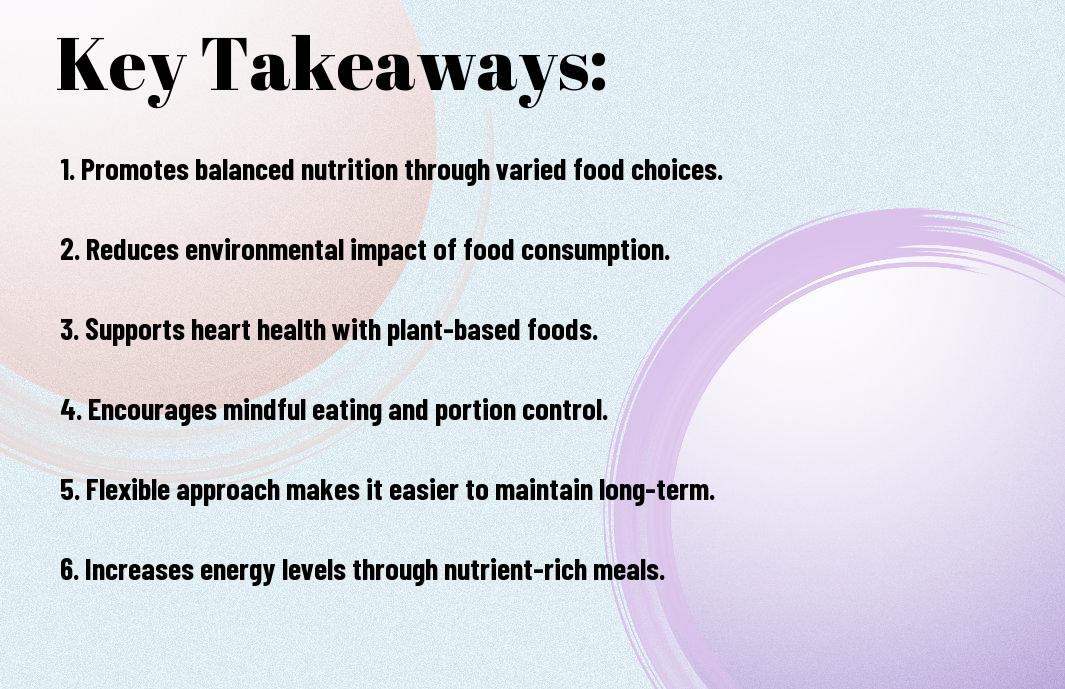Over the past few years, the flexitarian diet has grown in popularity due to its flexible approach to nutrition without strict restrictions. By allowing you to enjoy plant-based meals while accommodating occasional meat consumption, this diet can improve your overall health and wellbeing. You can experience benefits such as weight management, enhanced energy levels, and reduced risk of chronic diseases, all while enjoying a diverse and satisfying diet. In this post, we will examine deeper into the advantages of adopting a flexitarian lifestyle and how it can work for you.
Key Takeaways:
- Health Benefits: A flexitarian diet can improve overall health by reducing the risk of chronic diseases, thanks to its emphasis on plant-based foods.
- Environmental Impact: Adopting a flexitarian lifestyle contributes to lower carbon footprints, as it promotes the consumption of more sustainable food sources.
- Nutritional Flexibility: This diet allows for a balanced intake of nutrients, as it includes a variety of food groups while still focusing on healthful options.
- Culinary Variety: A flexitarian diet encourages trying new recipes and ingredients, enhancing meal enjoyment and culinary skills.
- Ease of Adoption: It’s a flexible approach to eating, making it easier for individuals to transition towards more plant-based foods without strict restrictions.
Understanding the Flexitarian Diet
For those looking to adopt a flexible approach to eating, the Flexitarian Diet offers a practical balance between vegetarian meals and occasional meat consumption. This dietary pattern encourages you to prioritize plant-based foods while still allowing for the enjoyment of meat and animal products in moderation. It is particularly appealing for individuals who wish to improve their health without fully committing to vegetarianism.
Definition and Principles
Principles of the Flexitarian Diet center around incorporating more fruits, vegetables, legumes, and whole grains into your meals while reducing meat intake. This diet does not impose strict rules; instead, it encourages you to make conscious choices that align with your personal preferences and lifestyle, aiming for a healthier, more sustainable way of eating that can easily be adapted over time.
Historical Context
Historical interest in plant-based diets has grown over the decades, influenced by various cultural practices and health movements.
Consequently, the Flexitarian Diet emerged as a response to the increasing awareness of health, environmental concerns, and animal welfare. It draws on established vegetarian practices but allows for flexibility, making it a more approachable option for those hesitant to give up meat entirely. As a result, this diet has gained popularity among people who seek to enjoy the benefits of plant-based eating while still savoring their favorite meat dishes occasionally.
Health Benefits
Clearly, adopting a flexitarian diet can significantly enhance your overall health. This flexible approach encourages the consumption of a variety of nutrient-rich foods, which can lead to improved heart health, reduced risk of chronic diseases, and enhanced digestive function. By incorporating more plant-based foods while still allowing some meat and dairy, you can enjoy a balanced intake of vital vitamins and minerals that promote vitality and longevity.
Nutritional Advantages
Before you begin on a flexitarian diet, it’s important to understand the nutritional advantages it offers. By focusing on whole foods such as fruits, vegetables, whole grains, and legumes, you increase your intake of fiber, antioxidants, and vital nutrients. This variety supports your immune system and contributes to better health outcomes, making it easier to meet your daily nutritional requirements while still enjoying the foods you love.
Impact on Weight Management
Advantages of a flexitarian diet include its positive impact on weight management. By emphasizing plant-based foods, you naturally reduce caloric intake while still feeling satisfied. This approach encourages you to make healthier choices, promoting a balanced and nutritious eating pattern that can keep you at a healthy weight without the need for restrictive dieting.
To manage your weight effectively with a flexitarian diet, focus on portion control and meal planning. By leaning towards whole, unprocessed foods and incorporating more fruits and vegetables into your meals, you can create satisfying dishes that fill you up with fewer calories. Additionally, this sustainable approach means you are less likely to experience the fatigue and frustration associated with traditional weight loss diets, leading to lasting changes in your eating habits.
Environmental Impact
All dietary choices contribute to environmental change, and adopting a flexitarian diet can significantly lessen your ecological footprint. By reducing meat consumption and increasing plant-based food intake, you support sustainable farming practices and resource conservation. This balanced approach not only boosts your health but also plays a part in tackling issues like deforestation, habitat loss, and water scarcity.
Sustainability and Resource Use
About 80% of the world’s agricultural land is used for livestock production, consuming a significant portion of our water and energy resources. By embracing a flexitarian diet, you can promote sustainable agricultural practices. This approach encourages diverse crop cultivation and rotation, leading to healthier soil and planets, as well as enhancing food security for future generations.
Reducing Carbon Footprint
By cutting down on meat and dairy, you can directly lower your carbon emissions. Livestock farming is one of the largest contributors to greenhouse gases, and reducing your intake helps mitigate climate change.
With a flexitarian diet, you can lower your carbon footprint significantly. The production of plant-based foods generally requires less energy, land, and water in comparison to meat. By making conscious decisions to prioritize fruits, vegetables, grains, and legumes, you actively contribute to a decrease in greenhouse gas emissions. Your choices can inspire others, forming a collective movement towards a more sustainable and environmentally friendly future.
Economic Considerations
To adopt a flexitarian diet can lead to significant economic benefits. By emphasizing plant-based meals and reducing meat consumption, you naturally decrease your food expenditure. This approach not only aligns with current health trends but also allows you to enjoy a diverse array of foods while keeping costs manageable. You’ll find that a balanced, flexible eating pattern can positively impact your overall budget.
Cost-Effectiveness of a Flexitarian Diet
Before you commit to a flexitarian lifestyle, consider the cost-effectiveness of this dietary choice. Incorporating more affordable plant-based proteins like beans, lentils, and whole grains can lower your overall grocery expenses. You still enjoy meat on occasion, allowing you to purchase higher-quality options without feeling guilty about overindulgence.
Impact on Grocery Bills
For many, shifting to a flexitarian diet can lead to a noticeable reduction in grocery bills. By prioritizing fruits, vegetables, grains, and legumes, you often spend less than if you focused predominantly on meat and dairy. This approach not only supports health but also aligns with budgeting strategies.
Hence, you can benefit financially from incorporating a flexitarian diet into your lifestyle. You’ll likely notice that whole foods and seasonal produce are often more affordable and accessible than packaged and processed options. By strategically planning your meals around plant-based ingredients and using meat as a flavoring rather than the main event, you can significantly reduce your overall grocery costs while enjoying a diverse and nutritious diet.
Incorporating Flexitarianism into Daily Life
Now that you’ve learned about the flexitarian diet, you may wonder how to seamlessly integrate it into your daily routine. Start by adopting a mindset that emphasizes plant-based foods while allowing for occasional meat consumption. You can find valuable insights in The Flexitarian Diet: A Detailed Beginner’s Guide. Meal prepping, realizing that balance is key, and experimenting with new recipes will make this lifestyle shift enjoyable and sustainable.
Meal Planning and Recipes
An effective way to embrace the flexitarian diet is through meal planning. Focus on incorporating a variety of vegetables, legumes, and whole grains into your meals, leaving meat for smaller portions. Explore creative recipes that use plant-based ingredients as the foundation, enhancing your culinary skills while making nutritious choices.
Overcoming Challenges
Behind any dietary change, challenges are bound to arise. You might find it difficult to adjust your meals, navigate social situations, or deal with cravings for meat. Yet, tackling these challenges can lead to growth and a deeper understanding of your eating habits.
This journey can present obstacles, whether adapting to new ingredients or facing skepticism from friends and family. You might overcome these hurdles by planning your meals, keeping healthy snacks on hand, and seeking out like-minded communities for support. Embrace flexibility and allow yourself the grace to make gradual changes, leading to a successful transition into the flexitarian lifestyle.
Case Studies and Success Stories
Not only does a flexitarian diet support a healthier lifestyle, but you can also find inspiring success stories that showcase its effectiveness. Here are some statistics from case studies demonstrating the impact this diet can have on your health:
- Participants in a six-month study lost an average of 10 pounds while following a flexitarian approach.
- A community-based program showed a 35% reduction in cholesterol levels among flexitarian followers.
- Surveys revealed that 60% of individuals reported improved energy levels after adopting a flexitarian diet.
- Another study found a correlation between the flexitarian diet and a 20% reduced risk of heart disease.
These examples illustrate that by incorporating more plant-based meals into your routine, you can achieve significant health benefits and make lasting changes to your well-being.
Final Words
Hence, adopting a flexitarian diet can provide you with numerous health benefits, from improved heart health to better weight management. By incorporating more plant-based foods while still allowing for the occasional meat, you can enjoy a balanced and varied diet that meets your nutritional needs. This approach not only supports your health but also promotes environmental sustainability. Embrace the flexitarian lifestyle to enhance your overall well-being without feeling restricted, making it a practical and enjoyable choice for your dietary journey.
Q: What is a flexitarian diet and how does it differ from vegetarian or vegan diets?
A: A flexitarian diet is primarily vegetarian but allows for occasional consumption of meat and fish. Unlike strict vegetarian or vegan diets that eliminate animal products entirely, the flexitarian approach offers flexibility, encouraging individuals to enjoy plant-based foods while still incorporating small amounts of animal products as desired. This can make it easier for those who may not want to commit fully to a vegetarian or vegan lifestyle but still want to reduce their meat intake for health or environmental reasons.
Q: What are the health benefits associated with adopting a flexitarian diet?
A: Adopting a flexitarian diet can lead to numerous health benefits. Research indicates that this approach can improve overall diet quality, as it emphasizes fruits, vegetables, whole grains, and legumes, which are high in imperative nutrients and fiber. It may also lower the risk of chronic diseases such as heart disease, diabetes, and certain cancers. Additionally, by reducing meat consumption, individuals may experience lower cholesterol levels and improved weight management, contributing to better overall health.
Q: How can I transition to a flexitarian diet if I’m currently eating a standard diet?
A: Transitioning to a flexitarian diet can be done gradually and doesn’t require a complete overhaul of your eating habits. Start by designating certain days of the week as meat-free, introducing more plant-based meals into your routine. Focus on incorporating a variety of vegetables, legumes, and whole grains to make meals hearty and satisfying. Experiment with alternative protein sources, such as beans, lentils, nuts, and tofu, to replace meat in your dishes. Over time, this approach allows your palate to adjust and encourages a healthier balance between plant-based foods and occasional meat consumption.


